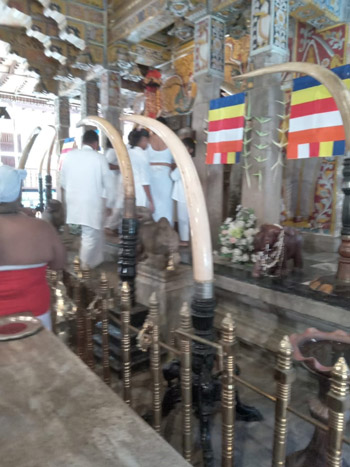Meepeni poojawa at the Sri Dalada Maligawa, a ritual connected with the Esala Perahera
 The Sri Dalada Perahera (pageant) or Esala Perahera which parades the streets of Kandy for ten nights is preceded by many age-old customs and rituals.
The Sri Dalada Perahera (pageant) or Esala Perahera which parades the streets of Kandy for ten nights is preceded by many age-old customs and rituals.
The first on August 5, was the ‘kap situweema’ (placing of a stump of a tree with a milky sap such as Jak) in the four Devalas: Natha, Vishnu, Kataragama and Pattini. Various rituals are performed in these devalas for five consecutive days. On August 10, the perahera was seen on the streets as Kumbal perahera and from the 15th until the 19th, it is the grand Randoli perahera.
The sound of whip crackers slashing their whips announces the arrival of the perahera. Flag bearers, drummers, dancers and colourfully caparisoned elephants and tuskers follow. First in line is the Maligawa perahera, followed by the Natha, Vishnu, Kataragama and Pattini devala peraheras.
After the last Randoli perahera which takes place this year on the 19th, only the Devala perahera will proceed to Getembe Thota for the diya kepeeme (water slashing/cutting) ceremony in the early hours of Nikini Full Moon Poya. The Maligawa perahera will proceed to the Asgiriya Gedige viharaya to place the Perahera Karanduwa in the viharaya until the following day, when the Devala perahera will join with the Maligawa Perahera and conclude the Esala Perahera by going round the Temple Square and entering the Dalada Malgawa. The Devala perahera will proceed to their respective devalas to end this year’s grand festival.
On the first day of the Randoli perahera, there is a meepeni pooja (offering of bees’ honey) to the Sacred Tooth Relic by the Adivasi (aboriginal) community commonly known as Veddahs (hunters) from Dambana. Members of the community begin collecting the honey with great devotion, well ahead of the visit to Kandy.
On the 15th, the Sunday Times witnessed this community of people with their chief Uruwarigé Wannila Ettho bringing honey to be offered at the Sri Dalada Malgawa in the morning. The Diyawadana Nilame received them and after the pooja they had a discussion. Refreshments were offered and the men were gifted with sarongs and the women cheetthaya (a coloured cloth). They were invited to view the Dalada Perahera at the Maha Maluwa in the evening.
In Buddhist history, there are instances of the Buddha receiving honey as food from people, devas and even animals.
Tapassu and Bhalluka welanda debayo (two merchant brothers) were travelling past the Kiripalu forest with 500 carts filled with their merchandise. Suddenly their carts got stuck in the mud. It is believed that this was orchestrated by Sakkra Deiyo to make them offer food to the Buddha, who seated under a Kiripalu tree after his Supreme Enlightenment, had not had any meal for a very long time. Seeing the Buddha, the merchants prepared food with bees’ honey and offered it to him. This was the first meal the Buddha had after his Enlightenment.
The Buddha preached the Dhamma to them and they became devotees as upasakas, the first disciples of the Buddha and Dhamma (the Sangha was not yet established). When they requested for something to worship, the Buddha stroking his head gave them a fist full of his hair.
After the Buddha’s parinibbana (passing away) the practice of offering honey is followed by Buddhists. During the time of the Sinhala kings, it was a custom for the Adivasi to offer honey to the Sacred Tooth Relic. This ancient practice had not continued due to many reasons but was revived in recent years.
When the Buddha was living in the Pareyya forest an elephant offered fruit to him. Seeing this, a monkey brought him a honeycomb. When the Buddha accepted it, the monkey overjoyed, went leaping from tree to tree but unfortunately fell to its death. It is believed that the monkey was reborn in a better realm because of its meritorious act.
In some Theravada Buddhist countries, the month the monkey died is called Madhu Poornima meaning Honey Full-Moon and in India and Bangladesh, Buddhists offer honey to monks to remember the monkey’s act.
Searching for an ideal partner? Find your soul mate on Hitad.lk, Sri Lanka's favourite marriage proposals page. With Hitad.lk matrimonial advertisements you have access to thousands of ads from potential suitors who are looking for someone just like you.


